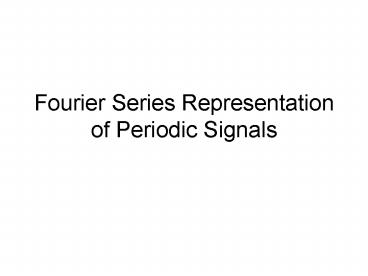Fourier Series Representation of Periodic Signals
1 / 80
Title:
Fourier Series Representation of Periodic Signals
Description:
The response of an LTI systems to a complex exponential input is the same ... essentially undistorted and significantly attenuate or eliminate others ... –
Number of Views:1246
Avg rating:3.0/5.0
Title: Fourier Series Representation of Periodic Signals
1
Fourier Series Representation of Periodic Signals
2
The Response of LTI Systems to Complex
Exponentials
- The response of an LTI systems to a complex
exponential input is the same complex exponential
with only a change in amplitude
3
The Response of LTI Systems to Complex
Exponentials(2)
- A signal for which the system output is a
constant times the input is referred to as an
eigenfunction of the system , and the amplitude
factor is referred to as the systems eigenvalue.
4
The Response of LTI Systems to Complex
Exponentials(3)
5
The Response of LTI Systems to Complex
Exponentials(4)
6
The Response of LTI Systems to Complex
Exponentials(5)
7
Example 3.1-1
8
Example 3.1-2
9
Fourier Series Representation of Continuous-Time
Periodic Signals
- A signal is periodic if
10
Example 3.2
11
Example 3.2(2)
12
F.S. Representation of Continuous-Time Periodic
Signals(2)
- Suppose that x(t) is real and can be represented
in - then
13
F.S. Representation of Continuous-Time Periodic
Signals(3)
14
F.S. Representation of Continuous-Time Periodic
Signals(4)
15
F.S. Representation of Continuous-Time Periodic
Signals(5)
16
F.S. Representation of Continuous-Time Periodic
Signals(6)
17
Example 3.3
18
Example 3.4
19
Example 3.4(2)
20
Example 3.5
21
Example 3.5(2)
22
Example 3.5(3)
23
Convergence of the Fourier Series
- Periodic signal x(t) by a linear combination of
a finite number
24
Convergence of the Fourier Series(2)
- The energy in the error over one period
- One class of periodic signals are represent
- -able through the F.S. those signals which
have finite energy over a single period
25
Convergence of the Fourier Series(3)
- Most of the periodic signals we consider do have
finite energy over a single period, they have
F.S. representation.
26
Dirichlet conditions 1
- x(t) must be absolutely integrable
27
Dirichlet conditions 1(2)
- A periodic signal that violates the first
Dirichlet conditions
28
Dirichlet conditions 2
- In any finite interval of time, x(t) is of
bounded variation that is, there are no more
than a finite number of maxima and minima during
any single period of the signal
29
Dirichlet conditions 2(2)
- An example of a function that meets condition 1
but not condition 2
30
Dirichlet conditions 3
- In any finite interval of time, there are only a
finite number of discontinuities - An example of a function that violates Dirichlet
conditions 3
31
Gibbs phenomenon
- xN(t) of a discontinuous signal x(t) will in
general exhibit high-frequency ripples and
overshoot x(t) near the discontinuous
32
Gibbs phenomenon(2)
33
Properties of Continuous-Time Fourier Series
34
Time Shifting
35
Time Reversal
36
Time Scaling
- The Fourier coefficients have not changed, the
Fourier series representation has changed because
of the change in the fundamental frequency
37
Multiplication
38
Conjugation and Parsevals Relation
- Conjugation
- Parsevals relation
39
Example 3.6
40
Example 3.6(2)
41
Example 3.7
42
Example 3.8
43
Example 3.8(2)
44
FS Representation of Discrete-Time Periodic Signal
- A discrete-time signal xn with period N
- The set of all discrete-time complex exponential
signals with period N
45
FS Representation of Discrete-Time Periodic
Signal(2)
- To consider the representation of more general
periodic sequences
46
FS Representation of Discrete-Time Periodic
Signal(3)
47
Example 3.10
48
Example 3.11
49
Example 3.11(2)
50
Example 3.12
51
Example 3.12(2)
52
Example 3.12(2)
53
Signal and system
54
3.7 Properties of discrete-time fourier series
- 3.7.1 Multiplication
- 3.7.2 First difference
- 3.7.3 Parsevals relation for discrete-time
periodic signals - 3.7.4 Example
55
3.7.1
- Multiplication
- Periodic convolution
- Aperiodic convolution
- Ranges form
56
3.7.2
- First difference
- Defined as
57
3.7.3
- Parsevals relation
- The average power in a periodic signal equals the
sum of the average powers in all of its harmonic
components
58
3.7.4
- Example 3.13
59
3.7.4
60
3.7.4
- Example 3.14
61
3.7.4
62
3.8 Fourier series and LTI systems
- Continuous-time LTI system
- Discrete-time LTI system
63
3.8
- Continuous-time
- Special case
- Discrete-time
- Focus in
64
3.8
- Continuous-time
- Example 3.16
65
3.8
66
3.8
- Discrete-time
- Example 3.17
67
3.8
68
3.9 Filtering
- 3.9.1 Frequency-shaping filters
- 3.9.2 Frequency-selective filters
69
3.9.1
- Frequency-shaping filters
- Linear time-invariant systems that change the
shape of the spectrum - Example
70
3.9.1
71
3.9.2
- Frequency-selective filters
- Systems that are designed to pass some
frequencies essentially undistorted and
significantly attenuate or eliminate others - Example
72
3.9.2
73
3.10 Examples of continuous-time filters
- 3.10.1 A simple RC lowpass filter
- 3.10.2 A simple RC highpass filter
74
3.10.1
75
3.10.1
76
3.10.2
77
3.11 Example of discrete-time filters
- 3.11.1 First-order recursive discrete-time
filters - 3.11.2 Nonrecursive discrete-time filters
78
3.11.1
79
3.11.2
80
3.11.2































